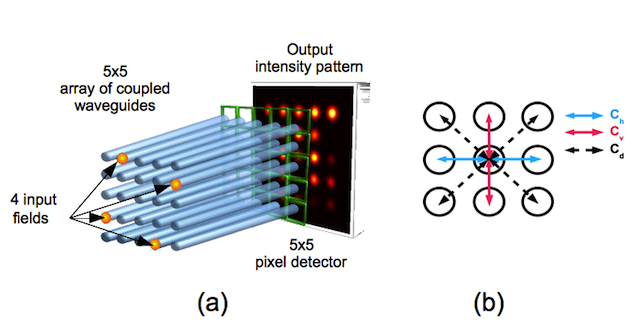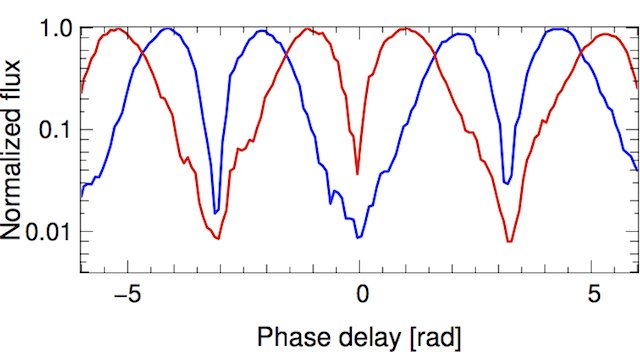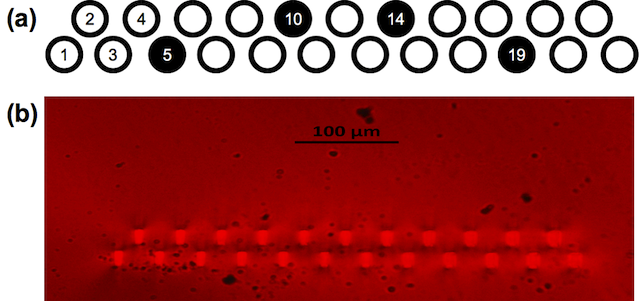1) Role of next-nearest-neighbour coupling in phase retrieval with photonic lattices
Photonic lattices (i.e. arrays of evanescently coupled waveguides) can be used as beam combiners for multi-telescope stellar interferometry. We discovered that a necessary condition for the photonic lattice to work as a multi-field interferometer is the existence of long-range coupling between the sites of the lattice (next-nearest-neighbour or second-order coupling). This property is intrinsic in 2D photonic lattices, while completely absent in 1D arrays of coupled waveguides. More details about the implications of this discovery for multi-field interferometry, quantum optics and solid-state physics can be found in:
for multi-telescope stellar interferometry. We discovered that a necessary condition for the photonic lattice to work as a multi-field interferometer is the existence of long-range coupling between the sites of the lattice (next-nearest-neighbour or second-order coupling). This property is intrinsic in 2D photonic lattices, while completely absent in 1D arrays of coupled waveguides. More details about the implications of this discovery for multi-field interferometry, quantum optics and solid-state physics can be found in:
S. Minardi, Phys. Rev. A 92, 013804 (2015). [preprint]
2) Integrated optics beam-combiner for 4-telescope nulling interferometry
Nulling interferometry is an astronomical technique which could enable the detection of faint companions (e.g. exoplanets) orbiting very close to the parent star. It exploits the different interferometric phase of the parent star and the angularly separated companion to null the light of the star and reveal the companion. The performance of nulling interferometry can be improved by combining simultaneously several pairs of telescopes. In a recent work, we manufactured and tested an integrated optics beam combiner suitable for the beam combination of 4 telescope in a nulling mode (Angel-Wolf configuration). We simulated in the laboratory the transit of a star over a linear array of 4 telescopes and demonstrated a starlight rejection up to a factor 100. More details about the experiment is found in:
companions (e.g. exoplanets) orbiting very close to the parent star. It exploits the different interferometric phase of the parent star and the angularly separated companion to null the light of the star and reveal the companion. The performance of nulling interferometry can be improved by combining simultaneously several pairs of telescopes. In a recent work, we manufactured and tested an integrated optics beam combiner suitable for the beam combination of 4 telescope in a nulling mode (Angel-Wolf configuration). We simulated in the laboratory the transit of a star over a linear array of 4 telescopes and demonstrated a starlight rejection up to a factor 100. More details about the experiment is found in:
R. Errmann, et al., Appl.Opt. 54, 7449 (2015). [preprint]
3) Zig-zag discrete beam combiners
A corollary of the discovery that long-range coupling is a necessary condition for using photonic lattices as interferometers (see result 1) is that zig-zag arrays of waveguides can be used as discrete beam combiners. The advantage of this geometry is that the waveguides are disposed on a quasi-linear chain which, contrary to square photonic lattices, allows unrestricted spectral dispersion of the interferometric signal. We found numerically that optimal interferometric combination of 4 telescopes can be achieved with a zig-zag array of 23 waveguides. Work is currently in progress to transfer the array design on a chalcogenide glass substrate (by means of ultrafast laser inscription) and characterize interferometrically the resulting mid-infrared beam combiner. Results will be presented at the upcoming SPIE Conference on Astronomical Instrumentation 2016:
lattices as interferometers (see result 1) is that zig-zag arrays of waveguides can be used as discrete beam combiners. The advantage of this geometry is that the waveguides are disposed on a quasi-linear chain which, contrary to square photonic lattices, allows unrestricted spectral dispersion of the interferometric signal. We found numerically that optimal interferometric combination of 4 telescopes can be achieved with a zig-zag array of 23 waveguides. Work is currently in progress to transfer the array design on a chalcogenide glass substrate (by means of ultrafast laser inscription) and characterize interferometrically the resulting mid-infrared beam combiner. Results will be presented at the upcoming SPIE Conference on Astronomical Instrumentation 2016:
R. Diener, et al., SPIE 9907, paper 9907-110 (2016).
